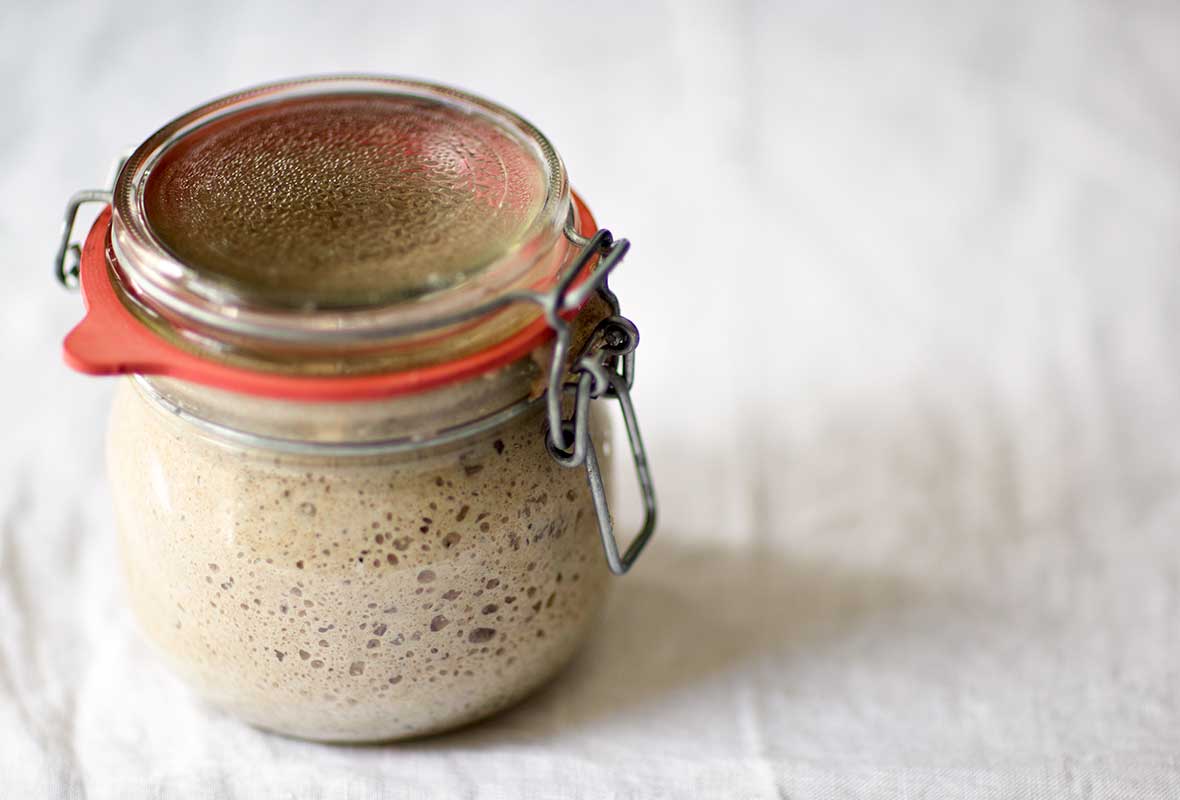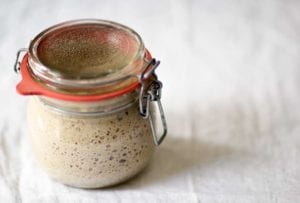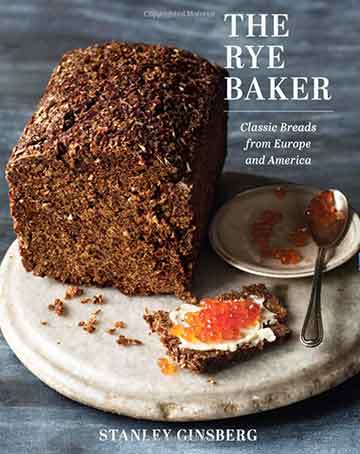
It’s not hard to make a rye sourdough starter from scratch. Some sourdough starters rely on wild yeasts that live in the air, others on acid-producing bacteria present in buttermilk, yogurt, pineapple juice, and the like, and still others start with commercial yeast or store-bought starters. Fact is, none of these additives is necessary. All it really takes to build a delicious and robust rye sour culture, or starter, is some whole-grain rye flour, water, a warm place, and patience. [Editor’s Note: And when your traditional rye sourdough starter is complete, the very first thing you’re going to want to do is use it to make this Galician rye bread.]–Stanley Ginsberg
☞ LEARN MORE, READ: HOW TO DRY SOURDOUGH STARTER

Rye Sourdough Starter
Ingredients
Day 1: Make the Rye Sourdough Starter
- 2.5 ounces whole grain rye flour, preferably organic
- 2.5 ounces warm water (105°F or 41°C)
Days 2 to 7: Refresh the Rye Sourdough Starter
- 2.5 ounces whole grain rye flour, preferably organic
- 2.5 ounces warm water (105°F or 41°C)
- 2.5 ounces Sour Starter from the preceding day
Days 8 and Beyond: Maintain the Rye Sourdough Starter
- 2.5 ounces medium or whole-grain rye flour, preferably organic
- 2.5 ounces warm water (105°F or 41°C)
- .25 ounces rye sourdough starter
Instructions
Day 1: Make the rye sourdough starter
- Start with equal amounts of organic rye flour and water by weight. Dump them in a nonreactive (glass, porcelain, stainless-steel, plastic) container, mix by hand into a stiff paste, cover, and let stand at room temperature (68 to 72°F or 20 to 22°C) for 24 hours.
☞ TESTER TIP: Occasionally the yeast normally present in whole grains fail to establish itself in a new culture; if, after 3 or 4 days, the culture darkens, develops a mold, or smells bad, dump the whole batch and start over. After a week, the culture, or sourdough starter, will be ready to use or to be stored refrigerated in an airtight container for a couple days. [Editor's Note: If storing the sourdough starter for more than a couple days, you'll need to maintain it, which we explain how to do just below.]
Days 2 to 7: Refresh the rye sourdough starter
- The next day, discard all but 2 1/2 ounces (70 grams) of the culture and mix the remainder with the refresh ingredients, cover, and let stand. Repeat each day, discarding all but 2 1/2 ounces (70 grams) of the preceding day’s culture.
☞ TESTER TIP: The most important point to remember at the early stages is to feed the sourdough starter daily. Even when it shows no apparent fermentation, the yeast is busy multiplying and consuming nutrients at a very high rate. By the second or third day, it will swell, show bubbles, and give off a clean sour smell. Over the next few days the activity will become more and more vigorous and the smell more intense.
Days 8 and Beyond: Maintain the rye sourdough starter
- In a perfect world—or in a working bakery—sourdough starters are refreshed daily. That said, daily feedings demand both a degree of dedication and abundant flour supplies that are impractical for all but the most committed home bakers. You can get by refreshing your starter every 36 hours or so.
- Mix the rye flour, water, and rye sourdough starter by hand until incorporated. Cover and ferment at room temperature (68 to 72°F or 20 to 22°C) overnight or for 10 to 12 hours. The sponge will be very bubbly, have a clean sour smell, and will have tripled in volume. Store refrigerated in an airtight container and it will last indefinitely.

Nutrition
Nutrition information is automatically calculated, so should only be used as an approximation.
Recipe Testers’ Reviews
The rye starter was easy to make and quick. It took about 5 minutes each of the 7 days. Mine smelled great and seemed consistent after the week of feedings. I switched to the refresh amounts after that and it stayed nice and healthy.
During the buildup, you end up tossing about 2/3 of it away. I definitely recommend a scale versus just using volume measurements.










Once rye starter has been made and then refrigerated after first use, can one get away with refreshing once a week while it rests in the fridge, as it could be two weeks or so before another bake.
Nigel, yes, that’s fine. That’s what I do. Once week. But…when I plan to make bread, I make sure to refresh it two days and then one day before I use it. You want it to be at its peak of strength.
Hi David, many thanks for your reply, glad I’m on the right track. In making my rye starter it more than doubled In size after day one. I have reduced it by half and re fed with 75g water & rye flour each day, but to my surprise it hasn’t risen that much on each of the last three days, only by about a quarter. Would that be normal and nothing to be worried about, and hopefully it’ll be ready after day 7. Thanks Nigel
Nigel, lucky you! Mine never doubles on the first day. You should be fine by the end of the week. If not, just go a few more days. Also, make sure to keep it in the same place. A warmer place will accelerate the rise.
Cheers David, the starter did very well and tried to break free overnight!!! Do you reckon I could try a bake tomorrow being the 6th day, as the starter seems to be doing well, or should I wait another couple of days? Much appreciated Nigel
Nigel, juuuuust to be safe, go the recommended number of days in the recipe, then go for broke with a bake!
Hi. Thanx for sharing this recipe. I’m making my first sourdough starter. When you say “cover does” it mean that I should close the lid of the jar or cover with a cheesecloth? Should I keep the jar on the counter or in a cupboard where it’s dark and out of reach somewhat?
Lastly, would I be able to use the starter in a bread maker? We have a gas shortage issue going on so I can’t use my oven 🙁
Thouraya, you don’t want to tightly cover the jar while the starter is growing; the accumulating gas needs to escape. I loosely cover it with the lid. I only tightly cover it when I place it in the fridge for storage. Cheesecloth will allow too much air in and might dry the top. I keep it on the counter, making it easy to feed.
Thanx, David. I will do that. What about using a bread maker to make sourdough bread? Would that be doable?
Sorry, Thouraya. I forgot to answer that. I’ve never used a bread machine, so I can’t speak to it personally. But I see many recipes out there for sourdough bread in bread machines. So I say, go for it!
Thanx soooo much. I will!
This is so exciting ?
Of course, Thouraya!
At what point can I used the discarded portion of the starter in baking and is that ok in any recipe? I also am curious how little starter I can leave left when baking (like on day 15, can you leave just a few grams of the starter to feed and bake with the rest)?
Evan, you want a fully mature starter, so use part of the starter from the eighth day. You can use the mature starter in any recipe that calls for a starter; just make sure to use the correct amount. I’m confused by your second question. Can you clarify?
Thanks, David. To clarify, I meant, how much starter should I leave to continue building moving forward?
Oh, I see. It’s always best to have a full recipe of starter, regardless of which recipe you’re following. For example with my starter (different from this one), I always keep it at about 200 grams so that I can use part of it and then build from that.